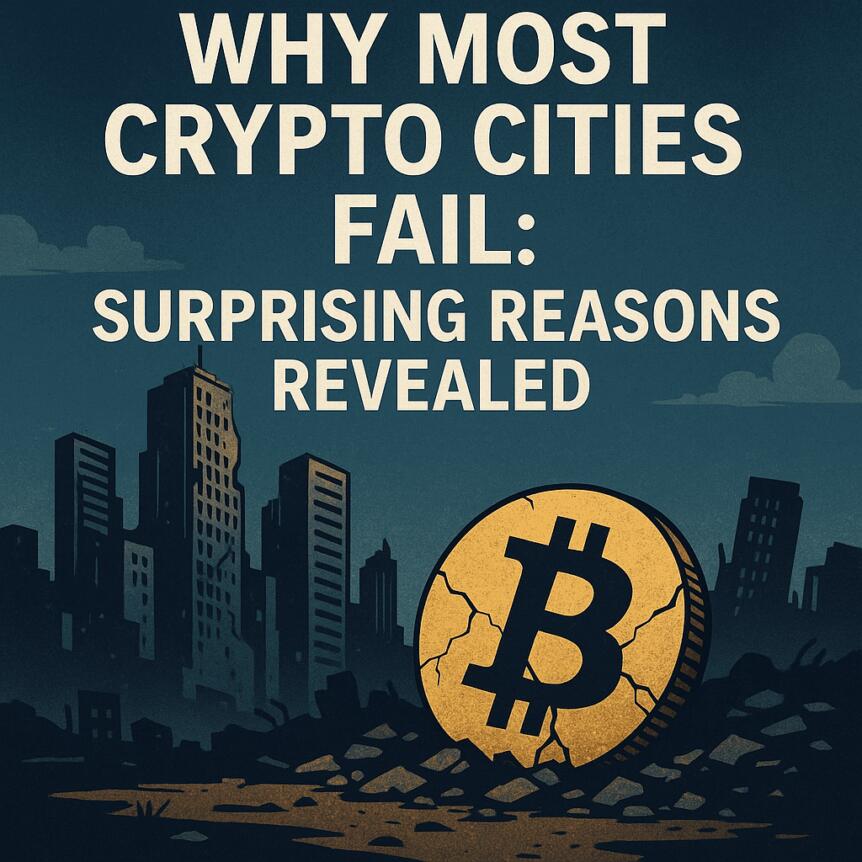Why Most Crypto Cities Fail: Surprising Reasons Revealed

Despite numerous ambitious projects and a growing interest in creating blockchain-driven “crypto cities,” most have fallen short of expectations or been outright abandoned. Industry experts now believe the key lies not in building entirely new autonomous zones but in integrating blockchain technology within existing urban frameworks. This shift toward modernization is shaping the future of crypto markets, regulation, and digital infrastructure.
- Many projects aiming to establish entirely crypto-powered cities have either failed or been abandoned.
- Experts suggest focusing on upgrading existing cities rather than creating standalone crypto communities.
- Blockchain technology is increasingly becoming part of mainstream urban infrastructure through government-backed initiatives.
- Pure crypto cities in ungoverned spaces face significant risks, from security to legal challenges.
- Partnerships with governments could accelerate the integration of crypto features into modern city-states.
While the idea of “crypto cities” has captured the imagination of enthusiasts and entrepreneurs for years, actual implementation remains elusive. Notable projects like Akon City, announced in 2018 as a $6 billion smart city powered by cryptocurrencies, have since been abandoned. Meanwhile, Satoshi Island, which launched in 2021 near Vanuatu to serve as a hub for crypto professionals, continues to work on infrastructure and licensing, but has not yet realized its full vision.
The ambitious plans for blockchain-powered cities like Puertopia in Ceiba and others have seen little progress or updates in recent years, illustrating the persistent difficulties in establishing fully autonomous crypto zones.
Crypto cities are solving the wrong problems
Ari Redbord, chief of policy and government affairs at blockchain intelligence firm TRM Labs, explains that many of these projects fail because they set goals that are nearly impossible to realize. The vision of a standalone city using blockchain for a completely independent economy—funded through tokens and operating autonomously—is too lofty.
Instead, Redbord advocates for modernizing existing urban centers. By integrating artificial intelligence to analyze risks, combat fraud, and enhance decision-making, along with implementing blockchain for transparency and trust, cities can benefit from blockchain technology without the need to create entirely new sovereignties.
A purely crypto city remains challenging
Kadan Stadelmann, CTO of blockchain platform Komodo, notes that self-sovereign cities—those completely independent of government—could theoretically exist in ungoverned zones like international waters. These would rely heavily on blockchain for transparency, security, and adaptability across sectors such as energy and food supply.
However, such endeavors demand significant sacrifice from residents and require a unified, dedicated community willing to forego modern conveniences temporarily. Nations and authorities pose threats through taxation and legal enforcement, and these unregulated spaces could be vulnerable to attacks or piracy, especially without police or military protection.
A better approach: Crypto zones within established cities
Vladislav Ginzburg, CEO of blockchain infrastructure firm OneSource, emphasizes that integrating blockchain in well-supported city-states like Dubai offers a more practical path than starting from scratch. Cities that have digitized government services demonstrate that modernization is achievable with the right backing.
Maja Vujinovic, CEO of FG Nexus, echoes skepticism about crypto cities without government backing, citing legal and property law challenges. She advocates for crypto-native neighborhoods within government-sanctioned zones, where working regulations around licenses, AML, and immigration are already in place.
Sean Ren, co-founder of Sahara AI, warns that entirely unregulated crypto cities are likely doomed if they attempt to operate outside government oversight. However, establishing regulatory sandboxes within existing cities to test new blockchain and AI solutions has real promise, offering valuable insights for broader policy development.
This article was originally published as Why Most Crypto Cities Fail: Surprising Reasons Revealed on Crypto Breaking News – your trusted source for crypto news, Bitcoin news, and blockchain updates.
You May Also Like

CME Group Inc. (CME) Stock: Rises as Q3 Earnings Beat Estimates Despite Revenue Dip

Wormhole launches reserve tying protocol revenue to token
